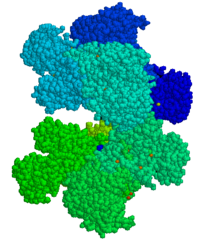
Photo from wikipedia
Aims/hypothesisIn addition to blood glucose concentrations measured in the fasting state and 2 h after an OGTT, intermediate measures during an OGTT may provide additional information regarding a person’s risk of… Click to show full abstract
Aims/hypothesisIn addition to blood glucose concentrations measured in the fasting state and 2 h after an OGTT, intermediate measures during an OGTT may provide additional information regarding a person’s risk of future diabetes and cardiovascular disease (CVD). First, we aimed to characterise heterogeneity of glycaemic patterns based on three time points during an OGTT. Second, we compared the incidences of diabetes and CVD and all-cause mortality rates among those with different patterns.MethodsOur cohort study included 5861 participants without diabetes at baseline from the Danish Inter99 study. At baseline, all participants underwent an OGTT with measurements of plasma glucose levels at 0, 30 and 120 min. Latent class mixed-effects models were fitted to identify distinct patterns of glycaemic response during the OGTT. Information regarding incident diabetes, CVD and all-cause mortality rates during a median follow-up time of 11, 12 and 13 years, respectively, was extracted from national registers. Cox proportional hazard models with adjustment for several cardiometabolic risk factors were used to compare the risk of diabetes, CVD and all-cause mortality among individuals in the different latent classes.ResultsFour distinct glucose patterns during the OGTT were identified. One pattern was characterised by high 30 min but low 2 h glucose values. Participants with this pattern had an increased risk of developing diabetes compared with participants with lower 30 min and 2 h glucose levels (HR 4.1 [95% CI 2.2, 7.6]) and participants with higher 2 h but lower 30 min glucose levels (HR 1.5 [95% CI 1.0, 2.2]). Furthermore, the all-cause mortality rate differed between the groups with significantly higher rates in the two groups with elevated 30 min glucose. Only small non-significant differences in risk of future CVD were observed across latent classes after confounder adjustment.Conclusions/interpretationElevated 30 min glucose is associated with increased risk of diabetes and all-cause mortality rate independent of fasting and 2 h glucose levels. Therefore, subgroups at high risk may not be revealed when considering only fasting and 2 h glucose levels during an OGTT.
Journal Title: Diabetologia
Year Published: 2017
Link to full text (if available)
Share on Social Media: Sign Up to like & get
recommendations!